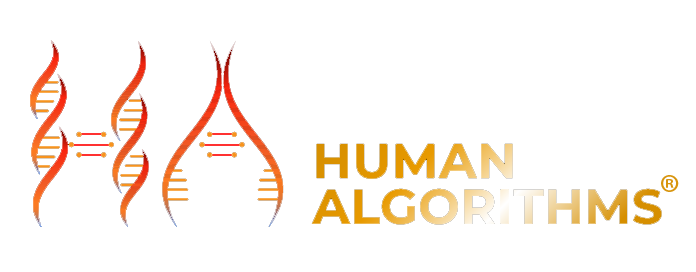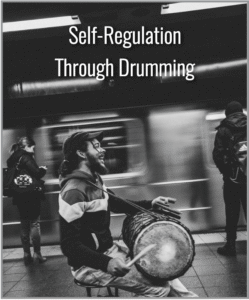Neuroregulation
Drumming - for stress reduction, trauma processing, social connection, and emotional expression.
 Drumming has emerged as a scientifically supported tool for enhancing mental health and emotional regulation. Research across neuroscience, psychology, and music therapy reveals its multifaceted benefits for stress reduction, trauma processing, social connection, and emotional expression. Below is a structured overview of the scientific significance of drumming in mental health:
Drumming has emerged as a scientifically supported tool for enhancing mental health and emotional regulation. Research across neuroscience, psychology, and music therapy reveals its multifaceted benefits for stress reduction, trauma processing, social connection, and emotional expression. Below is a structured overview of the scientific significance of drumming in mental health:
- Neurological and Physiological Effects
Activates the Brain’s Reward System
- Drumming stimulates dopamine release (Koelsch et al., 2010), activating the mesolimbic reward pathway.
- Creates pleasurable, mood-enhancing experiences similar to dancing or singing.
Synchronization of Brain Hemispheres
- Engaging in rhythmic, bilateral movement (e.g., hand drumming) supports integration of the left and right hemispheres, improving emotional regulation and cognitive flexibility.
Alters Brainwave Activity
- Repetitive drumming can induce alpha and theta brainwave states associated with deep relaxation, meditation, and creativity (Maxfield, 1994).
- Reduces Stress and Cortisol Levels
- Group drumming has been shown to reduce stress hormones such as cortisol (Bittman et al., 2001).
- It triggers a parasympathetic response, reducing physiological arousal and promoting calm.
- Trauma Healing and PTSD
Bottom-Up Regulation
- Trauma often disrupts bottom-up processing (from body to brain). Drumming engages the body rhythmically, promoting somatic regulation before cognitive insight.
Rhythm and Safety
- Rhythmic patterns restore a sense of predictability and safety, critical in trauma recovery (Porges’ Polyvagal Theory).
- Facilitates non-verbal expression of traumatic memory.
Neuroplasticity and Trauma Recovery
- Repetitive motor activity in a safe, rhythmic environment supports the formation of new neural pathways for safety and emotional control.
- Social Connection and Belonging
- Group drumming builds social synchrony and cohesion.
- Enhances feelings of belonging, shared purpose, and empathy through rhythm mirroring (Janata et al., 2012).
- Particularly beneficial in settings like support groups, schools, and correctional facilities.
- Emotional Expression and Regulation
- Provides a non-verbal outlet for processing complex or suppressed emotions.
- Encourages embodiment and agency, especially in populations where verbal expression is limited (e.g., autism, trauma survivors).
Evidence-Based Outcomes
| Study | Population | Outcome | ||||||||
| Bittman et al. (2001) | Healthcare workers | ↓ Stress, ↑ immune markers | ||||||||
| Fancourt et al. (2016) | Older adults | ↓ Anxiety, ↑ well-being | ||||||||
| Faulkner (2012) | Youth with behavioural difficulties | ↑ Self-regulation, ↓ aggression | ||||||||
| Winkelman (2003) | Cross-cultural | Drumming as ritual healing, ↑ psychosocial integration |
Clinical Applications
- Mental health groups (depression, anxiety)
- Trauma-informed therapy
- Autism and ADHD programs
- Addiction recovery
- Grief and bereavement counseling
- Cultural and community healing circles
Theoretical Models Supporting Drumming in Therapy
- Polyvagal Theory – Drumming engages the vagus nerve, improving social engagement and emotional regulation.
- Sensorimotor Psychotherapy – Emphasizes rhythmic body-based interventions for trauma healing.
- Expressive Arts Therapy – Drumming is used as a tool for creative expression and emotional release.
References
- Bittman, B. B., et al. (2001). Composite effects of group drumming music therapy on modulation of neuroendocrine-immune parameters in normal subjects. Alternative Therapies in Health and Medicine.
- Koelsch, S. (2010). Towards a neural basis of music-evoked emotions. Trends in Cognitive Sciences.
- Lynn-Seraphine, P. (2019). Self-regulation through drumming: A brain-body model for optimizing mental health. The Science of Psychotherapy, September 2019.
- Porges, S. W. (2011). The Polyvagal Theory: Neurophysiological Foundations of Emotions, Attachment, Communication, and Self-Regulation.
- Winkelman, M. (2003). Drumming and altered states of consciousness: A review of the evidence. Anthropology of Consciousness.
Humming - can support regulation, healing, and mood enhancement.
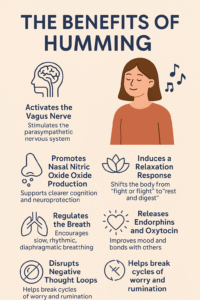 Humming, though often overlooked, has significant therapeutic potential for mental health and emotional well-being. It taps into a range of physiological, neurological, and psychological mechanisms that can support regulation, healing, and mood enhancement.
Humming, though often overlooked, has significant therapeutic potential for mental health and emotional well-being. It taps into a range of physiological, neurological, and psychological mechanisms that can support regulation, healing, and mood enhancement.
Scientific and Therapeutic Significance of Humming in Mental Health
- Activates the Vagus Nerve
Why it matters:
The vagus nerve is the main component of the parasympathetic nervous system, which governs rest, digestion, and relaxation.
- Humming stimulates the vagus nerve through vibration in the throat, chest, and diaphragm.
- This enhances vagal tone, associated with improved emotional regulation, reduced anxiety, and resilience to stress.
- Regular stimulation promotes heart rate variability (HRV), a key biomarker for mental and physical health.
Clinical Relevance:
Low vagal tone has been linked to anxiety disorders, depression, PTSD, and poor stress response. Humming may serve as a non-invasive way to upregulate parasympathetic function.
- Induces a Relaxation Response
Mechanism:
- Humming slows the breath and lengthens the exhalation.
- It shifts the autonomic nervous system from sympathetic (fight-or-flight) to parasympathetic (rest-and-digest) dominance.
- Helps reduce cortisol levels, heart rate, and blood pressure.
Useful for:
- Generalized Anxiety Disorder (GAD)
- Panic attacks
- Burnout and chronic stress
- Promotes Nasal Nitric Oxide Production
Why it matters:
- Humming has been shown to dramatically increase nasal nitric oxide (NO) levels—up to 15-fold in some studies (Lundberg et al., 2003).
- NO improves cerebral blood flow, neuroplasticity, and has anti-inflammatory and antimicrobial properties.
Mental health implications:
- NO may contribute to clearer cognition and enhanced mood by supporting oxygen delivery and reducing neuroinflammation, which is linked to depression and neurodegenerative diseases.
- Enhances Mindfulness and Present-Moment Awareness
Humming is rhythmical and self-soothing, providing a meditative anchor that helps people:
- Shift attention away from ruminative thoughts.
- Cultivate interoception (awareness of internal bodily states).
- Access flow states or deep relaxation.
Used in:
- Mindfulness-Based Stress Reduction (MBSR)
- Trauma-informed somatic practices
- Dialectical Behavior Therapy (DBT) and distress tolerance
- Regulates the Breath
Why it’s critical:
- Breath control is central to emotional regulation.
- Humming enforces slow, rhythmic breathing (often 5-6 breaths per minute), which synchronizes with coherent heart rhythms.
Applications:
- Biofeedback for anxiety and performance
- PTSD and emotional dysregulation disorders
- ADHD (as a tool for sensory-motor grounding)
- Releases Endorphins and Oxytocin
Psychobiological impact:
- Humming (especially in a group or musical context) stimulates the release of bonding and pleasure hormones, enhancing feelings of safety and connection.
- Oxytocin is known to reduce fear responses and improve social trust.
Therapeutic relevance:
- Social anxiety
- Depression
- Attachment trauma and loneliness
- Disrupts Negative Thought Loops
- Humming can override internal mental chatter, intrusive thoughts, or looping anxieties.
- It gives the brain a neutral or positive sensory task, interrupting maladaptive patterns.
Cognitive benefit:
- Supports behavioural activation
- Breaks obsessive-compulsive patterns
- Reduces self-critical inner dialogue
Applications in Clinical Practice
- Trauma Therapy: Humming is used in somatic experiencing, polyvagal-informed therapy, and sensorimotor psychotherapy to build nervous system safety.
- ADHD/Autism: Can be used as a sensory-regulating strategy for self-soothing.
- Music and Sound Therapy: Humming in certain frequencies (e.g., 528 Hz or solfeggio tones) is incorporated in sound healing and vibrational therapy.
Sample Humming Interventions
| Practice | Description | Duration | Goal |
| Humming Breath | Inhale through nose, hum softly on exhale | 3–5 mins | Calm & vagus activation |
| Bee Breath (Bhramari) | Yoga-based technique with closed ears | 5 mins | Reduce anxiety, enhance focus |
| Group Humming Circle | Communal humming with resonance | 10–15 mins | Bonding & endorphin release |
| Mindful Humming Journal | Daily note of emotional state before/after humming | 5 mins | Awareness & self-regulation |
Summary of Benefits
| Area | Effect of Humming |
| Nervous System | Stimulates parasympathetic tone |
| Breath & HRV | Slows breath, improves coherence |
| Brain Function | Enhances nitric oxide, reduces inflammation |
| Hormones | Increases oxytocin, endorphins |
| Mood | Reduces anxiety and promotes calm |
| Mindfulness | Encourages present-moment awareness |
Key Scientific Research on the Benefits of Humming
- Humming and Nasal Nitric Oxide Production
- Study: Humming greatly increases nasal nitric oxide
- Authors: Lundberg JO, Weitzberg E et al.
- Journal: American Journal of Respiratory and Critical Care Medicine (2003)
- DOI: 10.1164/rccm.200208-865OC
- Summary: Demonstrated that humming increased nasal nitric oxide levels by 15-fold. Nitric oxide has antimicrobial and neurovascular benefits, which may support cognitive function and mood regulation.
- Vagus Nerve Stimulation Through Vocalization
- Study: Vagal nerve stimulation: A new approach to treating anxiety and depression
- Authors: Nemeroff CB et al.
- Journal: Biological Psychiatry (2006)
- Summary: While this study focused on implanted VNS, it lays foundational knowledge for non-invasive stimulation (e.g., humming, chanting), showing effects on limbic structures and emotional regulation.
- Bhramari Pranayama (Bee Breath) and Mental Health
- Study: Immediate effect of Bhramari Pranayama on heart rate variability and perceived stress in healthcare students
- Authors: Telles S, Singh N et al.
- Journal: Journal of Ayurveda and Integrative Medicine (2021)
- DOI: 10.1016/j.jaim.2020.06.015
- Summary: Bhramari Pranayama, which involves humming, improved parasympathetic activity and reduced stress markers.
- Polyvagal Theory and Vocal Toning
- Author: Stephen Porges
- Book: The Polyvagal Theory: Neurophysiological Foundations of Emotions, Attachment, Communication, and Self-Regulation (2011)
- Relevance: Explains how vocalizations (like humming, chanting, and singing) stimulate the ventral vagal complex, promoting emotional safety and downregulating threat responses.
- Sound, Breath, and the Autonomic Nervous System
- Study: Effects of sound-based vagus nerve stimulation on emotion and autonomic function
- Authors: Konrad S et al.
- Journal: Frontiers in Psychology (2021)
- DOI: 10.3389/fpsyg.2021.647970
- Summary: Demonstrated the role of auditory/vocal interventions in modulating emotional states and autonomic function.
- Yoga and Mind-Body Techniques Using Humming
- Study: Effect of yoga breathing techniques on brain function
- Authors: Telles S, Naveen KV et al.
- Journal: Indian Journal of Physiology and Pharmacology (1997)
- Summary: Yogic breathing including humming showed EEG changes associated with increased parasympathetic activity and relaxation.
- Self-Generated Sounds for Stress and Anxiety
- Study: Effects of vocal toning on stress: A randomized controlled trial
- Authors: Perry N, Rubin RT
- Journal: Journal of Music Therapy (2018)
- Summary: Vocal toning (a close cousin of humming) significantly reduced cortisol levels and subjective anxiety.
Recommended Further Reading & Exploration
- Books:
- Accessing the Healing Power of the Vagus Nerve – Stanley Rosenberg
- The Healing Power of Sound – Mitchell Gaynor
- Keywords for literature search:
- “vagus nerve stimulation non-invasive”
- “humming nitric oxide”
- “vocal resonance and mood”
- “breathwork and autonomic nervous system”
Brain Waves - insights into how the brain functions during various states.
Brain waves are patterns of electrical activity generated by the neurons (nerve cells) in the brain. These waves can be measured and recorded using an electroencephalogram (EEG), a tool that places sensors on the scalp to detect these tiny voltage changes.
Why do they matter?
Brain waves provide insights into how the brain functions during various states. For example, increased beta waves might indicate focused thinking, while increased delta waves suggest deep sleep.
What are brain waves?
Brain waves are oscillating electrical signals produced by the synchronized firing of neurons. They reflect the brain’s overall state—whether alert, relaxed, or deeply asleep.
Frequency and Amplitude:
- Frequency (measured in Hertz, Hz) refers to how fast the waves are repeating per second.
- Amplitude refers to the strength or height of the waves.
Main Types of Brain Waves:
Each type of wave is associated with different states of consciousness:
- Delta (0.5–4 Hz): Deep sleep, unconsciousness.
- Theta (4–8 Hz): Light sleep, relaxation, creativity.
- Alpha (8–13 Hz): Calm wakefulness, relaxed focus.
- Beta (13–30 Hz): Alertness, active thinking, problem-solving.
- Gamma (30–100 Hz): Higher-level information processing, attention, complex tasks.
Summary:
Brain waves are fundamental to understanding how the brain transitions through different states of consciousness. They reveal the brain’s activity in real-time, acting as a window into our mental and emotional states.
Noise Colours - for mental health, sleep, concentration, relaxation, and sensory modulation.
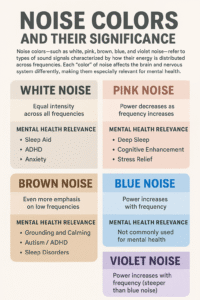 Noise colours, such as white, pink, brown, blue, and violet noise, refer to types of sound signals characterized by how their energy is distributed across frequencies. Each “colour” of noise affects the brain and nervous system differently, making them especially relevant for mental health, sleep, concentration, relaxation, and sensory modulation. Here’s an overview of each, including its significance in mental health:
Noise colours, such as white, pink, brown, blue, and violet noise, refer to types of sound signals characterized by how their energy is distributed across frequencies. Each “colour” of noise affects the brain and nervous system differently, making them especially relevant for mental health, sleep, concentration, relaxation, and sensory modulation. Here’s an overview of each, including its significance in mental health:
- White Noise
What It Is:
- Equal intensity across all audible frequencies.
- Sounds like a constant “shhh” (like a fan or static).
Mental Health Relevance:
- Sleep Aid: Helps mask background noises—useful for insomnia and sleep onset problems.
- ADHD: Can improve focus and reduce distractibility in individuals with ADHD (by reducing “internal” noise).
- Anxiety: Creates a consistent auditory environment that may feel calming to some.
Caution:
For some, the high-frequency component can be overstimulating.
- Pink Noise
What It Is:
- Power decreases as frequency increases – lower frequencies are more intense.
- Sounds like steady rainfall or rustling leaves.
Mental Health Relevance:
- Deep Sleep: Promotes stable sleep architecture (especially deep sleep), shown in studies using EEG.
- Cognitive Enhancement: Improves memory consolidation during sleep.
- Stress Relief: Lower, more soothing tones than white noise.
- Brown Noise (also called Red Noise)
What It Is:
- Even more emphasis on low frequencies than pink noise.
- Sounds like deep rumbling thunder or a strong waterfall.
Mental Health Relevance:
- Grounding and Calming: Low-frequency vibrations can reduce hyperarousal and overactivation in anxiety and trauma.
- Autism/ADHD: May support sensory regulation in individuals who are overstimulated.
- Sleep Disorders: Especially helpful for people who find white noise too harsh.
- Blue Noise
What It Is:
- Power increases with frequency (opposite of brown noise).
- Sounds like high-pitched hissing.
Mental Health Relevance:
- Not commonly used for mental health – more relevant in sound engineering.
- May be overstimulating or unpleasant for most listeners.
- Could potentially worsen anxiety or sensory overload.
- Violet Noise
What It Is:
- Even steeper increase in intensity with frequency than blue noise.
- Dominated by very high-pitched sounds.
Mental Health Relevance:
- Tinnitus Masking: Sometimes used for very specific high-frequency tinnitus treatment.
- Generally, not soothing – can be aversive, especially for those with sensory sensitivities.
How to Choose Noise for Mental Health Goals
| Goal | Best Noise Colour | Why |
| Fall asleep faster | White / Pink | Masks sounds; creates sleep-inducing environment |
| Deepen sleep | Pink / Brown | Supports slow-wave sleep; promotes memory |
| Reduce anxiety | Brown / Pink | Calming low tones mimic natural environments |
| Improve focus (ADHD) | White / Brown | Increases arousal to optimal level |
| Reduce sensory overload (ASD) | Brown / Pink | Soothing, low-frequency sounds reduce sensory input intensity |
| Tinnitus relief | White / Violet / Pink | Masks inner ringing depending on tinnitus frequency |
Research & Applications
- EEG studies show pink noise enhances deep sleep and memory consolidation.
- Brown noise is increasingly used in trauma-informed therapy and sensory rooms for emotional regulation.
- White noise machines are now common in sleep clinics and classrooms for ADHD support.
- Apps like Calm, Noisli, or MyNoise allow customization based on individual needs.
Considerations for Mental Health Professionals
- Individual Preference Matters: Some clients may find white noise soothing, others may find it aggravating.
- Context is Key: Sleep vs study vs calming vs grounding.
- Sensory Profiles: Especially for neurodiverse clients (e.g., autism, ADHD), test noise colours carefully.
- Use in Therapy: Can be paired with guided imagery, EMDR, or grounding exercises.
Neurotransmitters
Neurotransmitters Guide
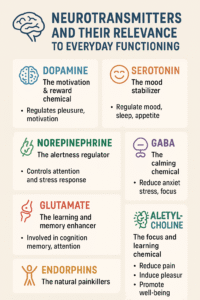 Neurotransmitters and Their Relevance to Everyday Functioning
Neurotransmitters and Their Relevance to Everyday Functioning
Neurotransmitters are chemical messengers in the brain that help regulate a wide array of bodily and mental functions. Their balance is vital for healthy cognition, mood, physical performance, and overall well-being.
- Dopamine – The Motivation & Reward Chemical
- Function: Drives motivation, reward, and goal-directed behavior
- Day-to-Day Role: Encourages productivity, enjoyment, and attention
- Imbalance Effects: Low motivation, fatigue, lack of focus
- Natural Boosters: Physical activity, protein intake, goal achievement
- Serotonin – The Mood Stabilizer
- Function: Regulates mood, sleep, appetite, and digestion
- Day-to-Day Role: Supports emotional stability, quality sleep, and satisfaction
- Imbalance Effects: Depression, anxiety, poor sleep
- Natural Boosters: Sunlight, exercise, complex carbohydrates
- Acetylcholine – The Focus & Learning Chemical
- Function: Facilitates learning, memory, and muscle control
- Day-to-Day Role: Helps focus, cognitive processing, and coordination
- Imbalance Effects: Poor memory, mental fog, sluggish thinking
- Natural Boosters: Choline-rich foods (e.g., eggs), mental challenges
- Norepinephrine – The Alertness Regulator
- Function: Manages attention, alertness, and the stress response
- Day-to-Day Role: Increases energy, readiness, and vigilance
- Imbalance Effects: Inattention, fatigue, low arousal
- Natural Boosters: Novelty, cold exposure, interval training
- GABA – The Calming Chemical
- Function: Reduces neuronal excitability to promote calmness
- Day-to-Day Role: Alleviates anxiety, promotes sleep and focus
- Imbalance Effects: Tension, irritability, insomnia
- Natural Boosters: Yoga, mindfulness, magnesium
- Endorphins – The Natural Painkillers
- Function: Dull pain and produce pleasurable sensations
- Day-to-Day Role: Enhance well-being, pain tolerance, and resilience
- Imbalance Effects: Sensitivity to pain, mood dips
- Natural Boosters: Laughter, socializing, physical exercise
- Glutamate – The Learning and Memory Enhancer
- Function: Main excitatory neurotransmitter for learning and cognition
- Day-to-Day Role: Critical for brain development and plasticity
- Imbalance Effects: Cognitive issues, neurotoxicity with excess
- Natural Boosters: Omega-3s, brain-healthy diet
- Oxytocin – The Bonding Molecule
- Function: Supports bonding, empathy, and social trust
- Day-to-Day Role: Promotes relationships, trust, and emotional warmth
- Imbalance Effects: Difficulty in connecting, loneliness
- Natural Boosters: Eye contact, hugs, affection, cooperative play
- Histamine – The Wakefulness Regulator
- Function: Maintains alertness and partakes in immune responses
- Day-to-Day Role: Promotes wakefulness and cognition
- Imbalance Effects: Drowsiness or allergic overreactions
- Natural Boosters: Balanced diet, hydration, managing allergens
- Anandamide – The Mood-Boosting Endocannabinoid
- Function: Regulates mood, memory, appetite, and pain
- Day-to-Day Role: Helps maintain internal balance (homeostasis)
- Imbalance Effects: Difficulty adapting to stress or imbalance in pleasure/pain
- Natural Boosters: Exercise (“runner’s high”), dark chocolate, meditation
Conclusion: Neurotransmitters work together to regulate our emotional states, cognitive functions, and physiological systems. Understanding and supporting these natural chemicals through lifestyle, diet, and mental health practices is crucial for overall mental and physical wellness.
Neurotransmitters & Food-Based Boosters
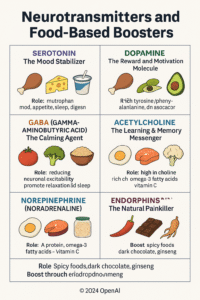 Major neurotransmitters and the foods that help boost their levels naturally, supporting mental and physical health.
Major neurotransmitters and the foods that help boost their levels naturally, supporting mental and physical health.
Neurotransmitters & Food-Based Boosters
- Serotonin – “The Mood Stabilizer”
- Role: Regulates mood, appetite, sleep, and digestion.
- Made from: Tryptophan (an amino acid)
- Boost through food:
- High-tryptophan foods:
- Turkey, chicken
- Eggs (especially yolks)
- Cheese, milk, yogurt
- Nuts and seeds (especially pumpkin and sunflower seeds)
- Tofu, soy products
- Salmon
- Oats and bananas
- Bonus tip: Pair with carbohydrates to help tryptophan cross the blood-brain barrier.
- High-tryptophan foods:
- Dopamine – “The Reward and Motivation Molecule”
- Role: Motivation, pleasure, attention, motor control.
- Made from: Tyrosine and Phenylalanine (amino acids)
- Boost through food:
- Rich in tyrosine/phenylalanine:
- Chicken, turkey, beef
- Eggs
- Dairy (cheese, milk)
- Soybeans and soy products
- Legumes (especially lentils)
- Dark chocolate
- Bananas
- Almonds and avocados
- Rich in tyrosine/phenylalanine:
- GABA (Gamma-Aminobutyric Acid) – “The Calming Agent”
- Role: Reduces neuronal excitability, promotes relaxation and sleep.
- Boost through food:
- Foods rich in glutamic acid/glutamate (GABA precursor):
- Tomatoes, mushrooms
- Broccoli, spinach
- Brown rice, whole grains
- Lentils
- Fermented foods (kimchi, sauerkraut, miso)
- Green and oolong tea
- Foods rich in glutamic acid/glutamate (GABA precursor):
- Acetylcholine – “The Learning & Memory Messenger”
- Role: Memory, learning, muscle control.
- Made from: Choline
- Boost through food:
- High-choline foods:
- Eggs (especially yolks)
- Liver
- Fish (salmon, cod)
- Soybeans, tofu
- Chicken, beef
- Brussels sprouts, broccoli, cauliflower
- High-choline foods:
- Norepinephrine (Noradrenaline) – “The Alertness & Focus Driver”
- Role: Attention, stress response, blood pressure.
- Made from: Tyrosine (same as dopamine)
- Boost through food:
- Protein-rich foods: Eggs, lean meats, fish, dairy
- Omega-3 fatty acids: Fatty fish (salmon, sardines), flaxseeds, walnuts
- Vitamin C: Oranges, bell peppers, kiwi (a co-factor in norepinephrine synthesis)
- Endorphins – “The Natural Painkiller”
- Role: Reduce pain, boost pleasure.
- Boost through food:
- Spicy foods: Chili peppers (capsaicin triggers endorphin release)
- Dark chocolate
- Ginseng
- Exercise also significantly boosts endorphins
Nutritional Co-Factors (Don’t Forget!)
These nutrients support neurotransmitter production and function:
- Vitamin B6 – Needed for serotonin, dopamine, GABA synthesis (sources: chickpeas, tuna, bananas)
- Magnesium – Supports GABA, dopamine (sources: leafy greens, nuts, whole grains)
- Zinc – Needed for brain plasticity and mood (sources: pumpkin seeds, beef, legumes)
- Omega-3s – Brain structure, dopamine & serotonin receptor sensitivity (sources: fish, flaxseed, chia)
Summary Chart (Quick Reference)
| Neurotransmitter | Key Nutrient | Best Foods |
| Serotonin | Tryptophan | Eggs, turkey, oats, bananas |
| Dopamine | Tyrosine | Chicken, dairy, soy, almonds |
| GABA | Glutamate | Brown rice, spinach, fermented foods |
| Acetylcholine | Choline | Eggs, liver, soybeans, salmon |
| Norepinephrine | Tyrosine + Vit C | Meat, citrus fruits, fatty fish |
| Endorphins | — | Dark chocolate, chili, ginseng |
Neurotransmitters & Nutrition: Boosting Brain Chemistry Through Food
This handout explores how everyday foods can naturally support neurotransmitter production – essential for mood, focus, memory, and emotional balance.
| Neurotransmitter | Function | Foods That Boost It |
| Serotonin | Mood, sleep, digestion | Turkey, eggs, cheese, seeds, bananas, oats |
| Dopamine | Pleasure, motivation, attention | Chicken, dairy, soy, dark chocolate, bananas, almonds |
| GABA | Relaxation, stress relief | Brown rice, spinach, broccoli, fermented foods, green tea |
| Acetylcholine | Learning, memory, muscle control | Eggs, liver, salmon, tofu, broccoli |
| Norepinephrine | Alertness, stress response | Meat, fish, citrus fruits, walnuts, flaxseed |
| Endorphins | Pain relief, pleasure | Dark chocolate, chili peppers, ginseng |
Supporting Nutrients:
– Vitamin B6: Chickpeas, tuna, bananas
– Magnesium: Leafy greens, nuts, whole grains
– Zinc: Pumpkin seeds, beef, legumes
– Omega-3s: Salmon, flaxseed, chia
Incorporating a diverse, nutrient-rich diet supports mental and emotional well-being by fuelling the brain’s chemical messengers. Use this guide to help clients make informed food choices for better mental health.
Neurotransmitters & Food-Based Boosters
 Major neurotransmitters and the foods that help boost their levels naturally, supporting mental and physical health.
Major neurotransmitters and the foods that help boost their levels naturally, supporting mental and physical health.
Neurotransmitters & Food-Based Boosters
- Serotonin – “The Mood Stabilizer”
- Role: Regulates mood, appetite, sleep, and digestion.
- Made from: Tryptophan (an amino acid)
- Boost through food:
- High-tryptophan foods:
- Turkey, chicken
- Eggs (especially yolks)
- Cheese, milk, yogurt
- Nuts and seeds (especially pumpkin and sunflower seeds)
- Tofu, soy products
- Salmon
- Oats and bananas
- Bonus tip: Pair with carbohydrates to help tryptophan cross the blood-brain barrier.
- High-tryptophan foods:
- Dopamine – “The Reward and Motivation Molecule”
- Role: Motivation, pleasure, attention, motor control.
- Made from: Tyrosine and Phenylalanine (amino acids)
- Boost through food:
- Rich in tyrosine/phenylalanine:
- Chicken, turkey, beef
- Eggs
- Dairy (cheese, milk)
- Soybeans and soy products
- Legumes (especially lentils)
- Dark chocolate
- Bananas
- Almonds and avocados
- Rich in tyrosine/phenylalanine:
- GABA (Gamma-Aminobutyric Acid) – “The Calming Agent”
- Role: Reduces neuronal excitability, promotes relaxation and sleep.
- Boost through food:
- Foods rich in glutamic acid/glutamate (GABA precursor):
- Tomatoes, mushrooms
- Broccoli, spinach
- Brown rice, whole grains
- Lentils
- Fermented foods (kimchi, sauerkraut, miso)
- Green and oolong tea
- Foods rich in glutamic acid/glutamate (GABA precursor):
- Acetylcholine – “The Learning & Memory Messenger”
- Role: Memory, learning, muscle control.
- Made from: Choline
- Boost through food:
- High-choline foods:
- Eggs (especially yolks)
- Liver
- Fish (salmon, cod)
- Soybeans, tofu
- Chicken, beef
- Brussels sprouts, broccoli, cauliflower
- High-choline foods:
- Norepinephrine (Noradrenaline) – “The Alertness & Focus Driver”
- Role: Attention, stress response, blood pressure.
- Made from: Tyrosine (same as dopamine)
- Boost through food:
- Protein-rich foods: Eggs, lean meats, fish, dairy
- Omega-3 fatty acids: Fatty fish (salmon, sardines), flaxseeds, walnuts
- Vitamin C: Oranges, bell peppers, kiwi (a co-factor in norepinephrine synthesis)
- Endorphins – “The Natural Painkiller”
- Role: Reduce pain, boost pleasure.
- Boost through food:
- Spicy foods: Chili peppers (capsaicin triggers endorphin release)
- Dark chocolate
- Ginseng
- Exercise also significantly boosts endorphins
Nutritional Co-Factors (Don’t Forget!)
These nutrients support neurotransmitter production and function:
- Vitamin B6 – Needed for serotonin, dopamine, GABA synthesis (sources: chickpeas, tuna, bananas)
- Magnesium – Supports GABA, dopamine (sources: leafy greens, nuts, whole grains)
- Zinc – Needed for brain plasticity and mood (sources: pumpkin seeds, beef, legumes)
- Omega-3s – Brain structure, dopamine & serotonin receptor sensitivity (sources: fish, flaxseed, chia)
Summary Chart (Quick Reference)
Neurotransmitter |
Key Nutrient |
Best Foods |
Serotonin |
Tryptophan |
Eggs, turkey, oats, bananas |
Dopamine |
Tyrosine |
Chicken, dairy, soy, almonds |
GABA |
Glutamate |
Brown rice, spinach, fermented foods |
Acetylcholine |
Choline |
Eggs, liver, soybeans, salmon |
Norepinephrine |
Tyrosine + Vit C |
Meat, citrus fruits, fatty fish |
Endorphins |
— |
Dark chocolate, chili, ginseng |
Neurotransmitters & Nutrition: Boosting Brain Chemistry Through Food
This handout explores how everyday foods can naturally support neurotransmitter production – essential for mood, focus, memory, and emotional balance.
| Neurotransmitter | Function | Foods That Boost It |
| Serotonin | Mood, sleep, digestion | Turkey, eggs, cheese, seeds, bananas, oats |
| Dopamine | Pleasure, motivation, attention | Chicken, dairy, soy, dark chocolate, bananas, almonds |
| GABA | Relaxation, stress relief | Brown rice, spinach, broccoli, fermented foods, green tea |
| Acetylcholine | Learning, memory, muscle control | Eggs, liver, salmon, tofu, broccoli |
| Norepinephrine | Alertness, stress response | Meat, fish, citrus fruits, walnuts, flaxseed |
| Endorphins | Pain relief, pleasure | Dark chocolate, chili peppers, ginseng |
Supporting Nutrients:
– Vitamin B6: Chickpeas, tuna, bananas
– Magnesium: Leafy greens, nuts, whole grains
– Zinc: Pumpkin seeds, beef, legumes
– Omega-3s: Salmon, flaxseed, chia
Incorporating a diverse, nutrient-rich diet supports mental and emotional well-being by fuelling the brain’s chemical messengers. Use this guide to help clients make informed food choices for better mental health.
Neurodivergence
How the Brain is Different in ADHD: A Scientific Overview
Introduction
Attention-Deficit/Hyperactivity Disorder (ADHD) is not just a behavioral diagnosis; it is rooted in distinct neurobiological differences. Advances in neuroimaging have allowed researchers to compare brain structure, activity, and chemistry in individuals with ADHD versus neurotypical individuals. These insights help explain the hallmark symptoms of inattention, hyperactivity, and impulsivity
- Key Brain Structures Implicated in ADHD
Prefrontal Cortex
- Function: Executive function, impulse control, attention regulation.
- ADHD Findings: Reduced volume and delayed cortical maturation.
- Implication: Difficulty with planning, organizing, and maintaining attention.
Basal Ganglia
- Function: Motor control, cognitive processing.
- ADHD Findings: Smaller caudate nucleus and putamen.
- Implication: Contributes to hyperactivity and difficulty with task initiation.
Cerebellum
- Function: Motor coordination and timing.
- ADHD Findings: Smaller posterior-inferior lobules.
- Implication: Affects timing and emotional regulation.
Corpus Callosum
- Function: Communication between brain hemispheres.
- ADHD Findings: Reduced size, especially in the splenium and isthmus.
- Implication: Slower information processing and integration.
- Brain Volume and Developmental Delay
Studies (e.g., Shaw et al., 2007) have shown a delay in cortical maturation in ADHD:
- Average 3-year delay in peak cortical thickness in the prefrontal regions.
- Normal developmental trajectory but slower timeline.
- Neurotransmitter Dysregulation
Dopamine and Norepinephrine:
- Dopamine: Key in reward processing and attention.
- Norepinephrine: Supports alertness and focus.
- ADHD: Dysregulated dopamine/norepinephrine pathways, especially in frontostriatal circuits.
- Result: Reduced motivation, difficulty sustaining attention.
Stimulant medications (e.g., methylphenidate) increase dopamine and norepinephrine in synaptic clefts, improving symptoms.
- Functional MRI (fMRI) Insights
- Default Mode Network (DMN): Overactive at rest and during tasks → leads to mind-wandering.
- Task-Positive Networks (TPN): Less activated in ADHD.
- Reduced functional connectivity between key attention networks.
- Structural Brain Volume Differences
The bar chart above illustrates average reductions in brain region volume for individuals with ADHD, relative to neurotypical controls:
| Brain Region | Typical Volume | ADHD Volume | |||
| Prefrontal Cortex | 100% | 90% | |||
| Basal Ganglia | 100% | 85% | |||
| Cerebellum | 100% | 88% | |||
| Corpus Callosum | 100% | 92% |
Conclusion
ADHD is a disorder deeply linked to neurodevelopmental differences. Understanding the structural and chemical brain changes helps reduce stigma and improve treatment precision. The future of ADHD intervention lies in neurobiological profiling, allowing personalized therapeutic approaches.
How the Brain is Different in Autism Spectrum Disorder (ASD) A Scientific Overview
Autism Spectrum Disorder (ASD) is a complex neurodevelopmental condition characterized by difficulties with social interaction, communication, and restricted or repetitive behaviors. It affects about 1 in 54 children globally and is increasingly understood as a condition with distinct neurological features. Modern neuroimaging and electrophysiological tools have provided substantial evidence that the brains of individuals with ASD differ structurally and functionally from neurotypical individuals.
- Overview of Brain Differences in ASD
Researchers have identified several consistent differences in the brains of people with ASD. These differences are not uniform across all individuals but commonly include:
- Atypical brain connectivity
- Differences in brain volume and structure
- Altered activity in social and sensory networks
- Neurochemical imbalances
- Structural Brain Differences
Early Brain Overgrowth
- Findings: MRI studies (Courchesne et al., 2003; Hazlett et al., 2011) show that children with ASD often exhibit increased total brain volume in the first 2 years of life, particularly in the frontal and temporal lobes.
- Interpretation: This overgrowth may relate to the early emergence of ASD symptoms, such as language and social delays.
Amygdala and Hippocampus
- Findings: The amygdala (emotion regulation) is often enlarged in young children with ASD but may become smaller or show abnormal growth trajectories later (Schumann et al., 2004).
- Implication: May explain heightened anxiety or altered fear responses.
Cerebellar Differences
- Findings: Reduced Purkinje cells in the cerebellum have been repeatedly noted (Fatemi et al., 2002).
- Role: The cerebellum contributes to motor coordination and also to social cognition and executive functioning.
- Functional Connectivity: Atypical Wiring
Hypo- and Hyperconnectivity
- Research (Just et al., 2007; Uddin et al., 2013): ASD brains often show:
- Hypoconnectivity between frontal and posterior brain regions (affecting integration of information).
- Hyperconnectivity in local circuits (possibly underlying repetitive behaviors or sensory sensitivities).
The Default Mode Network (DMN)
- Definition: A brain network active during rest and self-referential thought.
- ASD Link: Reduced DMN connectivity is associated with difficulties in theory of mind and introspection (Kennedy & Courchesne, 2008).
- Cortical Differences
Cortical Thickness and Folding
- ASD brains show greater cortical thickness in some areas (e.g., prefrontal cortex) and abnormal gyrification patterns (Ecker et al., 2013).
- These alterations may contribute to information processing differences.
- Neurotransmitter and Chemical Differences
- GABA (gamma-aminobutyric acid): Inhibitory neurotransmitter often reduced in ASD, possibly contributing to sensory hypersensitivity.
- Glutamate: Often elevated, contributing to excitatory-inhibitory imbalance (Robertson et al., 2016).
- Oxytocin and Serotonin: Linked to social bonding and mood, show irregular levels or receptor functioning.
- Electrophysiological Differences (EEG and ERP)
- EEG Patterns: Individuals with ASD often show increased theta and decreased alpha activity—associated with attentional modulation and sensory processing.
- Event-Related Potentials (ERP): Delays in response to facial expressions or eye contact (McPartland et al., 2004).
- Key Brain Regions Altered in ASD
- Frontal Lobe: Executive function, planning
- Temporal Lobe: Language, emotion
- Amygdala: Emotion processing
- Hippocampus: Memory
- Cerebellum: Coordination, learning
- Corpus Callosum: Communication between hemispheres
- Thalamus: Sensory relay
- Integrative Models: The Connectome Perspective
The “connectome” approach views the brain as a dynamic network. In ASD:
- Network modularity is higher (less integration between systems).
- Functional segregation may explain why individuals with ASD often excel in isolated cognitive tasks but struggle with holistic processing.
- Summary Table of Differences
| Feature | Typical Brain | ASD Brain | |
| Brain volume (infancy) | Normative | Enlarged (esp. frontal lobes) | |
| Amygdala | Normative | Enlarged or dysregulated growth | |
| Connectivity (global) | Balanced | Often reduced across hemispheres | |
| Local connectivity | Normative | Often increased | |
| GABA levels | Balanced | Often decreased | |
| Cortical thickness | Age-typical | Increased in some regions | |
| EEG alpha rhythms | Normative | Often reduced | |
| DMN activity | Consistent | Often reduced |
References
Courchesne, E. et al. (2003). Evidence of brain overgrowth in the first year of life in autism. JAMA.
Schumann, C.M. et al. (2004). Amygdala enlargement in toddlers with autism. Neuron.
Just, M.A. et al. (2007). Functional and anatomical cortical underconnectivity in autism. Neuroscience.
Uddin, L.Q. et al. (2013). Reconceptualizing functional brain connectivity in autism. Trends in Cognitive Sciences.
Ecker, C. et al. (2013). Brain anatomy and development in autism spectrum disorder. Lancet Neurology.
Kennedy, D.P. & Courchesne, E. (2008). The intrinsic functional organization of the brain is altered in autism. NeuroImage.
Robertson, C.E. et al. (2016). Reduced GABAergic action in the autistic brain. Current Biology.
McPartland, J. et al. (2004). Event-related brain potentials reveal anomalies in temporal processing of faces in autism. Journal of Child Psychology and Psychiatry.
Maenner, M. J., et al. (2023). Prevalence and Characteristics of Autism Spectrum Disorder Among Children Aged 8 Years — Autism and Developmental Disabilities Monitoring Network, 11 Sites, United States, 2020. MMWR Surveillance Summaries, 72(2), 1–14. https://doi.org/10.15585/mmwr.ss7202a1
